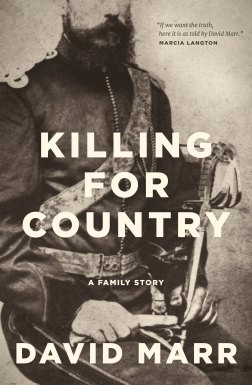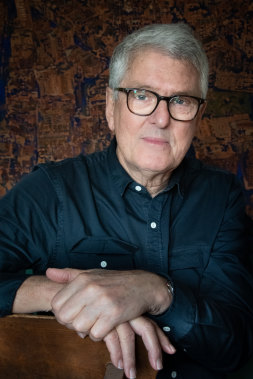Save articles for later
Add articles to your saved list and come back to them any time.
HISTORY
Killing For Country: A Family Story
David Marr
Black Inc., $39.99
In the early years of this century, Keith Windschuttle produced two volumes of a projected trilogy, The Fabrication of Aboriginal History, which became central to the history wars of the era. The first, published in 2002, purported to show that the colonisation of Van Diemen’s Land (Tasmania) was a relatively peaceful affair. The numbers killed in frontier violence, he argued, were far fewer than historians had claimed.
Credit:
Volume three in the trilogy claimed to demonstrate that the Stolen Generations were a myth. Oddly, no volume two has ever appeared. As a result, we have never been allowed to see how Windschuttle might go about proving that the notorious Queensland frontier, or, for that matter, the blood-soaked estates of the other mainland colonies, were tranquil places where God-fearing colonists attached to British law and order established their sheepwalks and cattle runs without much bloodshed.
David Marr’s powerful Killing For Country: A Family Story might help explain, as well as to fill, this apparent gap. Marr’s account is a relentless exposé of the violence at the heart of the colonisation of Australia. It is also something of a family saga: Marr is a descendant of the migrants on which the book focuses, the Uhr family.
Their Australian career unfolded mainly under the patronage of a sticky-fingered emigrant merchant, pastoralist, politician and philanthropist, Richard Jones. Jones engaged a brother-in-law, Edmund Uhr, in helping him to expand his pastoral holdings. With ambition that well and truly outstripped his ability, Uhr later ran – badly – a sheep boiling-down works in Maryborough, served as a magistrate, and ended up as Sergeant-at-Arms of the Queensland Parliament.
Killing Aboriginal people became a family business when Reg, Edmund’s son, established a career as an officer in the Native Mounted Police. Younger brother D’arcy, also in this force for a time, and rather more wild and more famous, was celebrated as a cheeky and hard-living larrikin of the type Australians are said to love. A compulsive liar, aggressive racist and serial killer, he was responsible over many decades for murders of Indigenous people in Queensland’s Gulf country, the Northern Territory, and the Western Australian goldfields.
Land-grabbing and its corollary, the massacre of Indigenous people, provided the unifying theme of this family’s early history. There must be many Australians who have such stories in their genealogy. They, like the rest of us who have inherited this history, will recently have heard from Senator Jacinta Nampijinpa Price that, far from having suffered from colonisation, Indigenous people have it to thank for benefits such as running water. Those being killed in their tens of thousands in frontier warfare would not have been aware of such advantages, even if they had been invited to consider them before they were shot.
Marr shows that colonists evolved a discreet system for clearing Aboriginal people from their land through slaughter without incurring serious risk of interference by the authorities. Indeed, the vague instructions issued by British-appointed governors and, later, elected colonial governments about what was and was not permissible gave something close to carte blanche to white vigilantes and Aboriginal “police” charged with keeping order.
The latter were usually recruited from distant places such as the southern colonies, so that they would be as foreign to the Aboriginal people of Queensland as the white colonisers who had hired them. The violence was often extreme and fuelled by the “spoils” that the Native Police, in essence a military force, gained from their efforts, such as access to women.
David Marr has uncovered a huge amount of evidence.Credit: Lorrie Graham
The recruitment of other Aboriginal men to do this dirty work also gave white officers an alibi should the killing be questioned by their superiors. They could allow the Aboriginal men under their command to kill freely in the bush and then obfuscate about what had gone on. That killing did not only happen in the backblocks: Marr details a chilling massacre in the town of Maryborough itself, in plain sight of residents. There was, as usual, no punishment for the perpetrators.
Marr suggests that after the Myall Creek massacre of 1838, that saw the execution of some of the killers of Aboriginal women and children, colonists adapted. Some turned to poisoning, which would be nearly impossible to trace and punish. Colonists also became more discreet, establishing what Marr calls “a curious but brutally effective omertá … a code that let so much be written in the papers about massacres but saw nothing done about them in the courts”.
“Dispersal” was a favourite euphemism, but colonial scribes were masters of evasion. It is chilling to read the offhand way a contemporary could refer to police having “inflicted punishment on the savages in the usual manner.”
Marr has uncovered a vast array of evidence of this killing in a monumental research effort. He has made excellent use of the richness of colonial newspapers, now accessible via the National Library of Australia’s superb Trove database. These are often surprisingly revealing of frontier violence. Marr’s archival research is also deep, and he has been assiduous in working with family and local researchers, as well as historical societies and regional archives. He is familiar with all the major historical and archaeological research. It is a fabulous feat of scholarship.
This evidence is brought to life by one of the country’s most accomplished non-fiction writers.
I was sometimes reminded of Robert Hughes’ study of convict transportation, The Fatal Shore (1987), in the epic quality of this book. And as Marr occasionally reminds us, he is traversing some of the territory also travelled by Judith Wright, in her admired family histories of colonisation. Like that great poet’s writing last century, which contributed to the reappraisal of the darker aspects of Australia’s history, Killing For Country is a timely exercise in truth-telling amid a disturbing resurgence of denialism.
Frank Bongiorno is Professor of History at the Australian National University.
The Booklist is a weekly newsletter for book lovers from books editor Jason Steger. Get it delivered every Friday.
Most Viewed in Culture
From our partners
Source: Read Full Article




